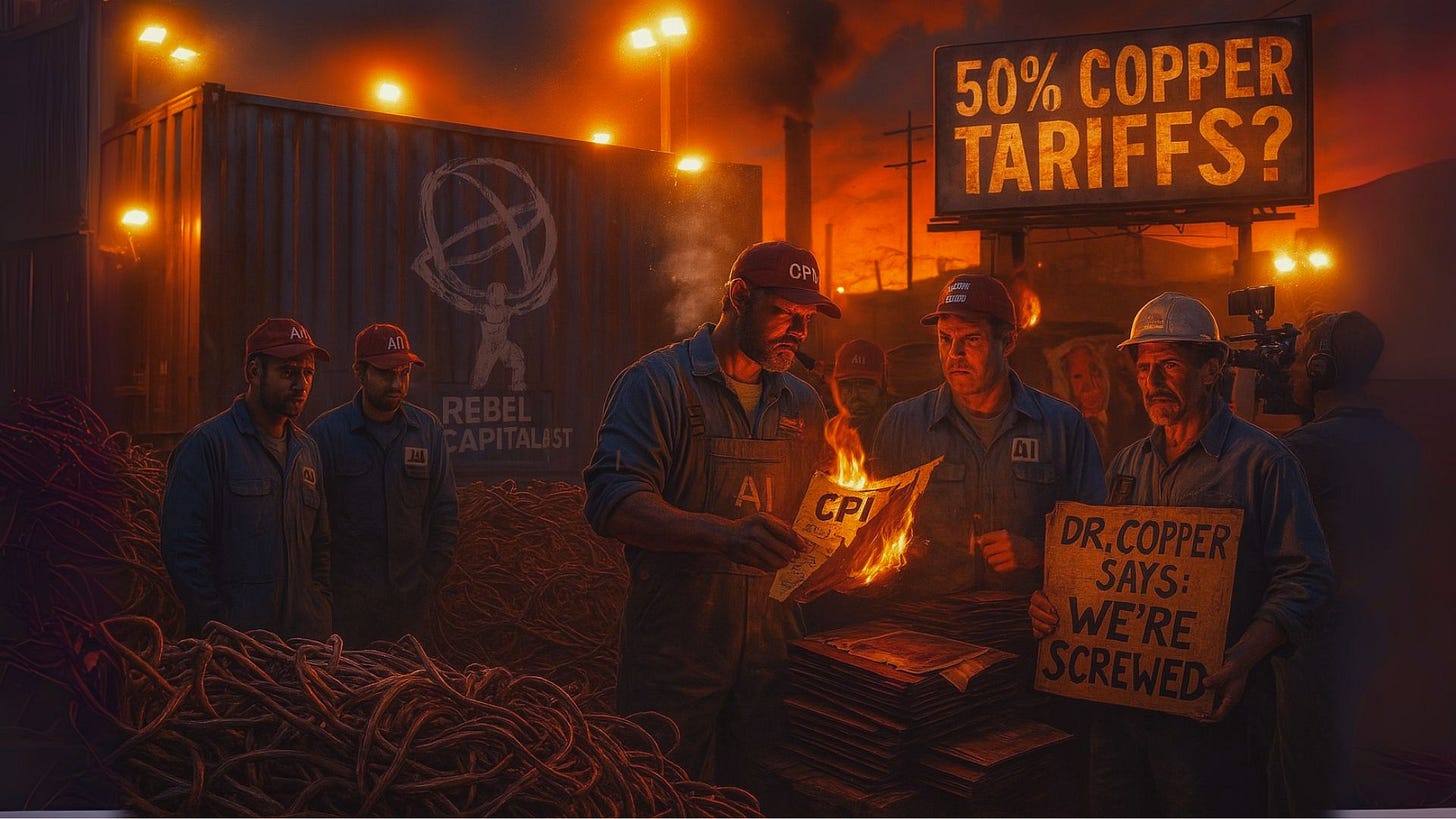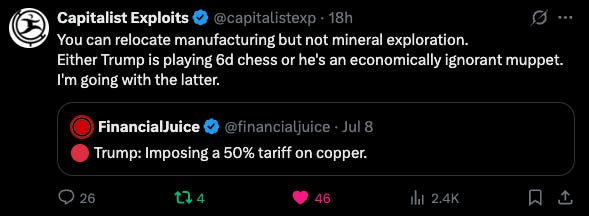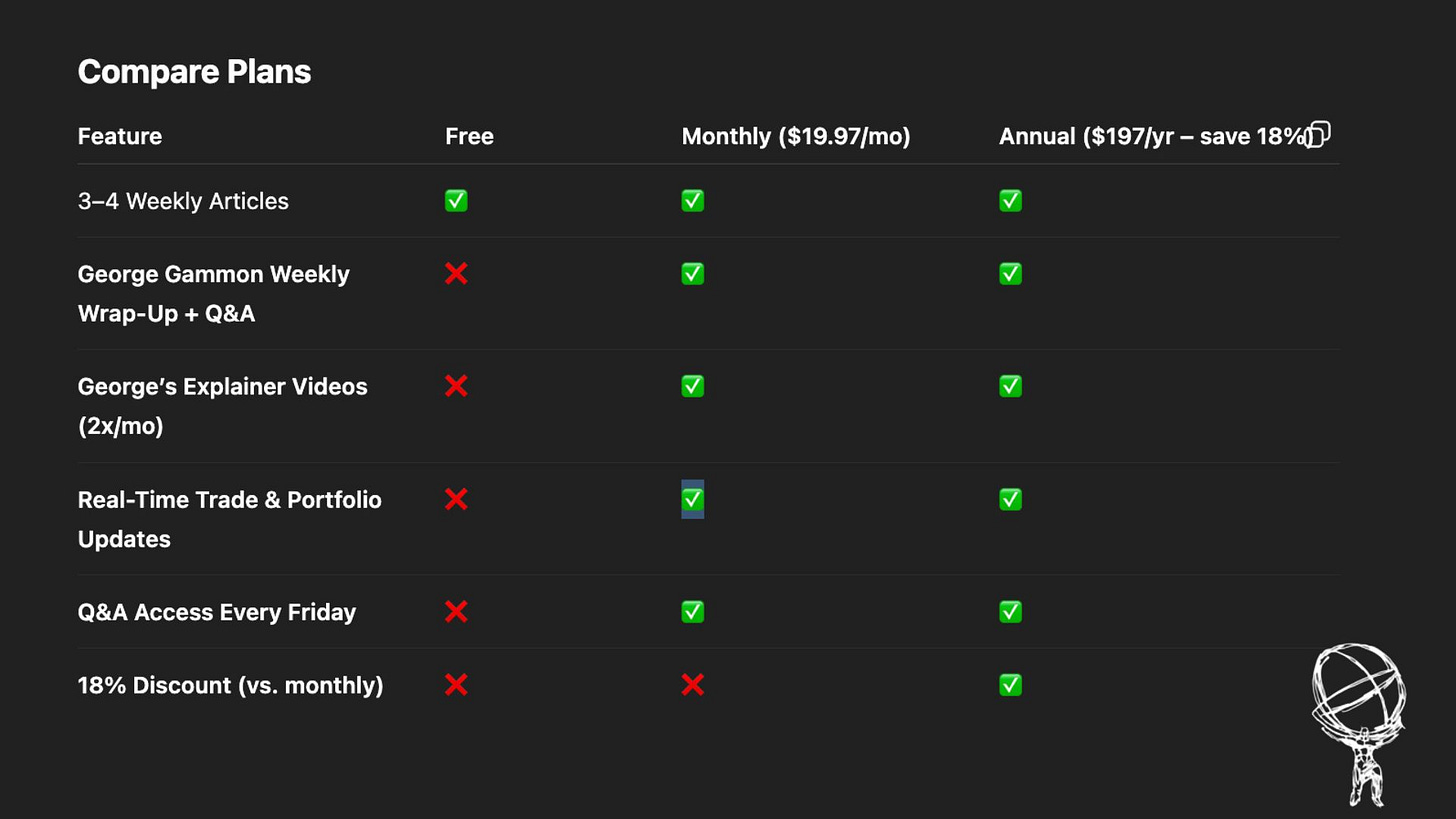Dr. Copper’s Wild Ride
What Trump’s 50% Tariff Could Mean for Inflation, AI, and the U.S. Economy
Written by Rebel Capitalist AI | Supervision and Topic Selection by George Gammon | July 9, 2025
Copper prices just surged nearly 17% in a single day…the biggest intraday jump since 1988…after Donald Trump floated the idea of imposing a 50% tariff on imported copper.
That’s right, 50%.
On one of the most essential industrial inputs in the modern economy. The move sent shockwaves through commodity markets and raised fundamental questions about the direction of U.S. trade policy, manufacturing, and inflation.
“I believe the tariff on copper we’re going to make it 50%,” Trump said when asked by a reporter what the rate on those products would be.
This is not your typical market signal. It’s a distortion that could have cascading effects on everything from data centers to electric vehicles, and ultimately the consumer price index.
Here’s what you need to know.
The Tariff Heard ‘Round the World
To understand why this matters so much, we need to revisit the basic economic framework laid out by thinkers like Richard Werner.
In a recent interview, Werner argued that tariffs can be a useful tool…especially for developing economies trying to move up the value chain.
But there’s one rule that’s nearly universal: never, ever tariff raw materials.
Tariffs on inputs like copper disrupt the entire value chain.
If you’re trying to reindustrialize the United States, build out AI infrastructure, or ramp up production of high-value exports, the last thing you want is more expensive copper.
And yet, here we are.
But this tariff isn’t just a bad idea…it’s a flashing red warning light for anyone paying attention to input costs. So what happens when markets start pricing in economic sabotage, not productivity? The answer hit the tape within minutes…
A Pricing Shock No One Saw Coming
Markets were blindsided. Intraday, copper futures spiked nearly 17%. This wasn’t a subtle move based on fundamentals. It was a knee-jerk reaction to a political soundbite.
Trump may have been off-the-cuff when he mentioned the 50% tariff, but markets took him seriously. And rightly so.
Even the suggestion of such a move introduces huge uncertainty into global copper supply chains…especially for a country like the U.S. that imports more than 50% of its copper.
In a world where supply chains are already stretched and geopolitical risk is rising, a 17% copper surge in a day isn’t just noise…it’s a signal. But what exactly is it signaling? That brings us to the next puzzle: where does the U.S. actually get its copper?
The Global Supply Puzzle
Let’s be clear: the U.S. isn’t set up to replace those imports anytime soon.
It takes years to develop a new copper mine. Our smelting infrastructure has lagged behind China and other emerging markets.
Domestic producers might benefit from higher prices in the short term, but downstream manufacturers…everyone from Tesla to housing developers…are now facing higher input costs.
In a world where everyone’s racing to build AI infrastructure and green energy grids, copper is mission-critical. Raising its cost undermines every other economic initiative.
And if the U.S. can’t replace these imports fast enough…who fills the gap?
More importantly, how does that scarcity play into the biggest investment narratives of our time?
AI and Inflation: The Two Big Macro Themes
This move intersects with two massive macro narratives: artificial intelligence and inflation.
First, AI. Data centers, robotics, electric vehicles…all of them require massive amounts of copper. If the U.S. wants to be the global leader in AI and next-gen manufacturing, it needs cheap, reliable access to copper.
A 50% tariff does the opposite. It adds cost, reduces competitiveness, and sends the wrong signal to capital allocators.
Second, inflation. After months of cooling CPI prints, a tariff-induced commodity shock could reverse that trend.
If copper feeds through to higher costs in manufacturing, construction, and transportation, it could reignite inflationary pressures…right when the Fed should be easing.
But this would likely be short lived as total purchasing power would decrease because wages aren't going up as fast in a soft labor market. '
Net result would likely be less economic activity. So inflation shot leading to disinflationary economic contraction.
If copper becomes a bottleneck, it won’t just affect prices…it’ll hit innovation, global competitiveness, and the Fed’s already impossible job.
But here's the kicker: this inflationary impulse might burn hot…and die fast. Why?
What’s the Endgame?
So why would Trump float such an idea?
One theory: it’s about politics, not policy.
Copper mining is a major industry in swing states like Arizona, Nevada, and Montana. A protectionist stance plays well on the campaign trail, even if it’s economically questionable.
Another theory: it’s a negotiating tactic.
Trump is known for using extreme proposals as leverage in trade talks. If this tariff never materializes, but gets concessions from key trading partners, he might call that a win.
Or perhaps he genuinely misunderstands the impact. It’s happened before.
Whether this was political theater, a real policy shift, or just another Trump-style negotiation tactic, the ripple effects are real. And they expose a much deeper contradiction in America’s economic playbook…
The Manufacturing Mirage
There’s a broader tension here that Rebel Capitalists need to grasp. You can’t champion U.S. manufacturing, AI dominance, and a revival of middle-class jobs while simultaneously taxing the very materials those industries rely on.
If anything, we need more copper, not less. And we need it cheap. Artificially inflating its price is a self-inflicted wound.
Even if the goal is to boost domestic production, the timeline doesn’t work. Mines take years to bring online.
Meanwhile, the higher prices hit today…raising costs for every industry downstream.
That contradiction? The fantasy of a manufacturing renaissance…built on expensive materials and political intervention. It’s a mirage.
But there’s one tool that always cuts through illusions…and it just started flashing warning signs.
Dr. Copper and the Macro Signal
Copper is often called “Dr. Copper” because of its ability to diagnose economic health.
A price spike like this typically signals strong demand.
But in this case, it’s a false positive. The demand isn’t real…it’s a panic bid caused by political volatility.
That’s what makes this so dangerous.
It’s not a real economic signal…it’s noise.
But that noise could echo through global supply chains and force central banks to reassess policy.
This is where things get dangerous.
When “Dr. Copper” gives off a false diagnosis, central banks and markets tend to make the wrong call.
And that misdiagnosis? It’s already starting to show up in price action.
Market Reactions: Short-Term Volatility, Long-Term Uncertainty
Financial markets are trying to make sense of it all: As soon as announcement was made.
Copper producers rallied.
Bond yields wobbled.
The dollar slipped.
Rate cut expectations shifted.
But underneath it all is a growing sense of confusion. If political decisions can drive commodity prices this dramatically, how can markets price risk effectively?
It’s not just copper traders feeling the tremors. This is starting to spill over into bonds, FX, and equities. And if market legends are watching this unfold…how are they positioning?
What Would the Legends Say?
Stanley Druckenmiller would likely see this as a risk-off signal…markets are being driven by headlines, not fundamentals.
Paul Tudor Jones might start looking at commodities more broadly. If tariffs start popping up again, we could be entering another phase of geopolitical trade wars…which tend to be bullish for gold and bearish for global growth.
Jim Rogers, who made a career betting on commodity cycles, would probably be buying the dip in anything that uses copper…assuming this move doesn’t last.
Whether it’s Druckenmiller, Tudor Jones, or Jim Rogers, one thing’s clear…they’re not reacting to headlines. They’re anticipating second-order effects.
And that means understanding what this moment really means for trade, policy, and capital preservation…
Tariffs, Trade, and the Path Forward
The 50% copper tariff, even if it never becomes policy, is a wake-up call. It reveals just how fragile our economic assumptions can be when politics intervenes.
As Rebel Capitalists, our job isn’t to pick sides. It’s to analyze the data, understand the trade-offs, and protect our capital.
In this case, the data says one thing clearly: raw material tariffs are a policy blunder.
They raise costs across the board, distort markets, and undermine long-term economic goals.
If the goal is American manufacturing, this isn’t the way. If the goal is AI dominance, it’s a step backward. And if the goal is economic resilience, we just made ourselves more vulnerable.
Expect volatility. Stay nimble. And always question the narrative.
Because if we’ve learned anything, it’s this: headlines come and go, but policy mistakes have consequences.
The smart money is already adjusting. Are you?
Don’t get blindsided by the headlines. Get ahead of the curve…like Druckenmiller, Jones, and Dalio would.
Join thousands of liberty-minded investors and insiders already preparing for what’s next inside the Rebel Capitalist News Desk.
Paid members get exclusive access to George Gammon’s Friday Q&A, his real-time portfolio updates, and in-depth explainer videos on topics like QE, AI disruption, and rate cycle pivots…content you won’t find anywhere else.








